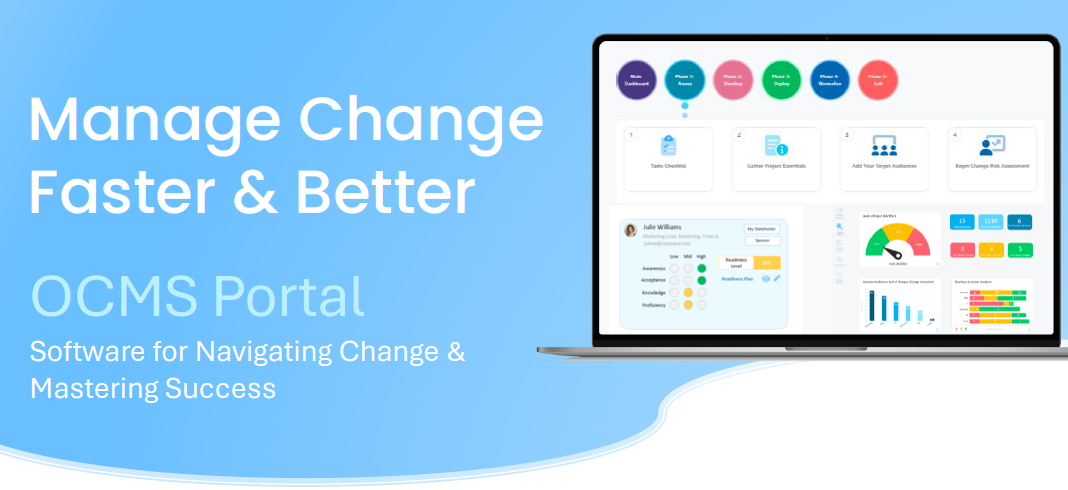The Hidden Threat of Change Fatigue: How to Prepare for and Mitigate Change Fatigue Impacts
As a change management practitioner, recognizing the early warning signs of change fatigue is vital to ensuring successful transformations while maintaining employee well-being. In this article, we’ll dive into the causes, symptoms, and long-term consequences of organizational change fatigue, while offering practical strategies to prevent burnout and manage change effectively.
By proactively addressing these challenges, you can foster a healthier, more resilient workforce during times of continuous transformation at your organization.
In today’s rapidly evolving business landscape, organizational change is not just inevitable but essential for staying competitive in a world driven by new technologies and market dynamics. However, the constant stream of overlapping projects and transformation initiatives can overwhelm employees, leading to change fatigue—also known as change saturation or change exhaustion. This occurs when employees are bombarded with too many changes in too short a time, resulting in stress, disengagement, and ultimately burnout.

Story Highlights
|
What is Change Fatigue?
Change fatigue definition: Change fatigue is a state of emotional and physical exhaustion that results from prolonged exposure to organizational changes.
It’s a common occurrence in today’s fast-paced business environment, where companies are constantly adapting to new technologies, market trends, and evolving customer expectations. When employees are subjected to frequent or significant changes, they may experience feelings of stress, anxiety, and overwhelm. Change practitioners need to understand change fatigue meaning and develop ways to anticipate and lessen its impact.
What are the Causes of Change Fatigue?
Several factors can contribute to change fatigue in organizations:
- Frequency and Scope of Changes: The more frequent and significant the changes, the greater the likelihood of employees experiencing change fatigue symptoms.
- Lack of Communication: Poor communication about changes can lead to uncertainty, confusion, and anxiety among employees. It also leads to employees resisting change.
- Insufficient Support: Employees may feel overwhelmed and experience personal change fatigue if they don’t have adequate support to navigate the changes.
- Overwhelming Workload: Increased workload or changes in responsibilities can contribute to change fatigue at work.
- Personal Stressors: Personal challenges or stressors can exacerbate the impact of organizational change on employees.
Please let us know if you have any questions about employees and change relating to change fatigue at work. We’ll be happy to help with some strategies.
Change Fatigue Symptoms
Overcoming organizational change fatigue and change burnout is part of the job of a change management team. Recognizing the early warning signs of organizational change fatigue is essential for addressing the issue before it escalates and leads to employees resisting change.
Some common change fatigue symptoms to look for when managing employees and change are:
- Decreased productivity: Employees may struggle to concentrate or complete tasks efficiently. This could mean they are suffering from change saturation.
- Low morale: Employees may feel disengaged, demotivated, or unhappy with their work as a result of the impact of organizational change on employees.
- Increased absenteeism: Employees may take more sick days or be late for work when feeling change exhaustion.
- High turnover rates: Employees may be more likely to quit their jobs. This is one of the costly symptoms of change fatigue in organizations because companies may lose valuable talent.
- Resistance to change: Employees may become resistant to future changes or adopt a negative attitude towards organizational initiatives. Employees resisting change is a common result of change fatigue in the workplace.
- Physical symptoms: Employees may experience physical symptoms such as fatigue, headaches, or digestive problems. These are more extreme symptoms of change burnout and change fatigue at work.
Consequences of Organizational Change Fatigue
Change fatigue can have significant negative consequences for both employees and organizations. Some of the potential consequences include:
- Decreased employee morale and engagement: Change management fatigue can lead to a decline in employee morale and engagement, which can negatively impact productivity. It can also cause a decrease in customer satisfaction.
- Increased turnover: High turnover rates can be costly for organizations in terms of recruitment, training, and lost productivity. When planning for managing change fatigue, organizations need to keep in mind the high costs of hiring and training new staff.
- Reduced innovation: What is change fatigue to innovation and creativity? It can stifle it. Employees may become reluctant to take risks or try new things due to feeling overwhelmed.
- Damaged organizational culture: Organizational change fatigue can erode trust and collaboration among employees, leading to a negative organizational culture. Managing change fatigue should include open dialogue that encourages feedback, so everyone feels heard.
Do you have any questions or feedback about the change fatigue meaning or change fatigue definition in this article? Please reach out and let us know.
How to Proactively Identify Change Fatigue: The Role of Technology
While human observation and intuition are valuable tools, technology can also play a crucial role in proactively identifying and managing change fatigue. One effective approach is to leverage change management software that can track employee engagement across various projects.
By analyzing employee data from these platforms, organizations can gain valuable insights into:
- Overlapping projects: Identify instances where employees are involved in multiple projects simultaneously, which can increase their workload and contribute to personal change fatigue.
- Training and communication gaps: Assess whether employees have received adequate training and communication regarding the changes, as these factors can significantly impact their ability to cope.
- Employee engagement levels: Monitor employee engagement metrics, such as participation in training sessions, completion of surveys, and feedback on change initiatives. A decline in engagement can be a red flag for potential change saturation.
With this information, change management teams can:
- Coordinate project timelines: Adjust project schedules to reduce the overlap between initiatives and alleviate employee workload.
- Tailor training and communication: Develop targeted training programs and communication strategies to address the specific needs of different employee groups.
- Identify at-risk employees: Proactively reach out to employees who may be struggling to cope with change fatigue in the workplace and provide additional support or resources.
By using technology, such as the OCMS Portal platform, to monitor employee engagement and identify potential risks, organizations can take a more proactive approach to managing change fatigue and ensure a smoother transition to new ways of working.
Are you still wondering, “What is change fatigue?” Reach out, we’ll be happy to help with some resources.
Tips for Overcoming Organizational Change Fatigue
To prevent and mitigate change management fatigue, organizations should implement strategies to support employees during times of change. Here are some practical tips for managing change fatigue:
- Effective Communication: Ensure that employees are kept informed about changes and the reasons behind them. Provide clear and timely communication to address concerns and alleviate uncertainty. Be upfront about employees and change, acknowledging the change fatigue meaning and efforts to mitigate burnout.
- Employee Involvement: Involve employees in the change process to foster a sense of ownership and buy-in. Seek their input and feedback to identify potential challenges and find solutions.
- Provide Support and Training: Offer employees the necessary support and training to navigate the changes successfully. This may include workshops, coaching, or mentoring.
- Prioritize Work-Life Balance: Encourage and enable employees to maintain a healthy work-life balance to reduce stress and prevent burnout.
- Recognize and Reward Efforts: Acknowledge and reward employees for their contributions during times of change. This can help boost morale and motivation and mitigate change exhaustion.
- Monitor Employee Well-being: Regularly assess employee morale and engagement to identify early signs of organizational change fatigue. Implement measures to address any issues before they escalate.
- Phased Implementation: Consider a phased approach to changes to minimize disruption and allow employees to adjust gradually to help avoid the impact of organizational change on employees.
- Celebrate Successes: Celebrate milestones and achievements to reinforce positive outcomes and maintain momentum. This type of encouragement goes a long way toward neutralizing change fatigue in organizations.
Please let us know if you have any feedback or questions about managing change fatigue in the workplace. We’d love to hear from you.
Conclusion: Identifying and Overcoming Organizational Change Fatigue
Change fatigue in the workplace is a significant challenge that organizations must address to ensure employee well-being and organizational success. By understanding the causes, symptoms, and consequences of change fatigue, and implementing effective strategies to prevent and manage it, organizations can create a more supportive and resilient workplace.
Remember, organizational change fatigue is not an inevitable consequence of employees and change in organizations. By taking proactive steps to identify it, address employee needs, and foster a positive change culture, organizations can navigate transformations successfully and minimize the negative impacts on their workforce.
Use Tools That Provide Visibility into Potential Change Saturation
Change burnout and change fatigue in the workplace often happen because change managers and project managers don’t have the visibility they need. They’re unaware of other projects impacting the same groups of people as their project.
OCMS Portal helps you solve this lack of visibility. It provides a single platform where all your change management teams can work. This enables administrators to see across all projects, identify overlapping training and communications, and ward off organizational change fatigue before it negatively impacts the organization.
FAQ: Change Fatigue Definition & Symptoms
What is change fatigue?
Change fatigue is a state of emotional and physical exhaustion by employees that results from prolonged exposure to organizational changes.
What are some negative impacts that can happen due to change exhaustion?
Some of the negative impacts that make up the change fatigue meaning for organizations include: Employees resisting change, low morale, absenteeism, damage to organizational culture, and reduced innovation.
What are some change fatigue symptoms?
Common symptoms of change fatigue in organizations include decreased productivity, low morale, high turnover rates, resistance to change, and physical symptoms such as fatigue, headaches, or digestive problems.
Note: Content on OCM Solution's ocmsolution.com website is protected by copyright. Should you have any questions or comments regarding this OCM Solutions page, please reach out to Ogbe Airiodion (Change Management Lead) or the OCM Solutions Team today. OCM Solution was previously known as Airiodion Global Services (AGS).
External Sources: stock.adobe.com





